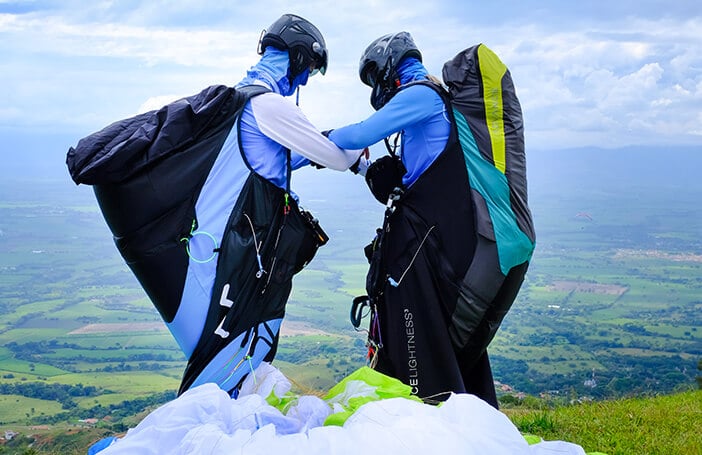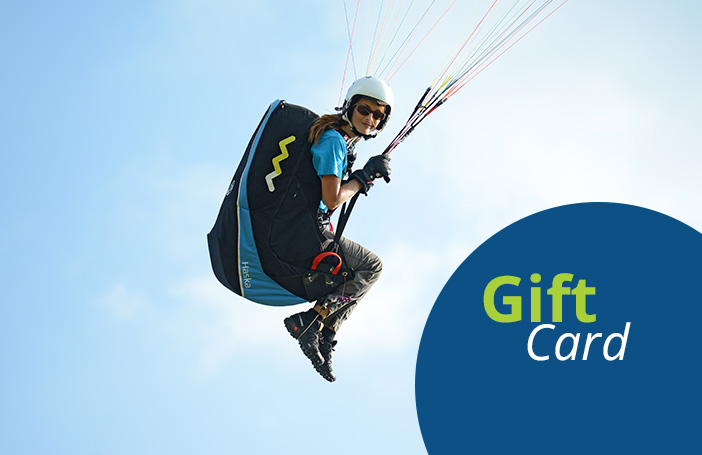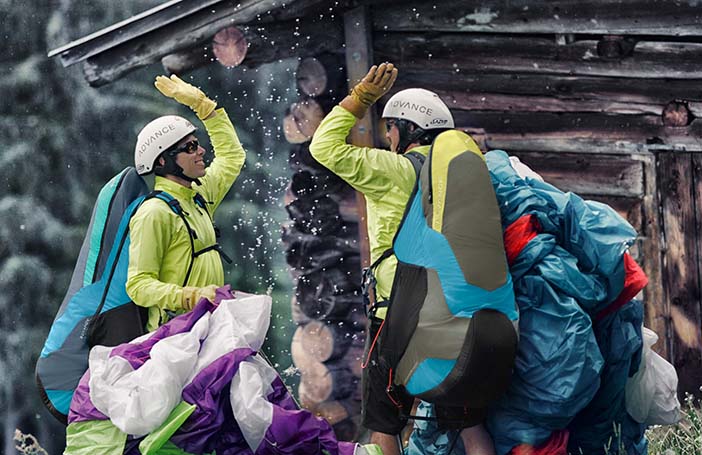Technical data
| Size |
75+ |
85+ |
105+ |
120 |
| Weight range from - to (kg) EN/LTF A |
- |
- |
65 - 85 |
65 - 100 |
| Weight range from - to (kg) EN/LTF B |
- |
50 - 85 |
86 - 105 |
101 - 120 |
| Weight range from - to (kg) EN/LTF C |
50 - 95 |
86 - 105 |
106 - 120 |
- |
| Area flat (m²) |
16.3 |
18.7 |
21.1 |
23.1 |
| Area projected (m²) |
14.0 |
16.0 |
18.1 |
19.8 |
| Aspect ratio flat |
4.33 |
4.33 |
4.33 |
4.33 |
| Aspect ratio projected |
3.27 |
3.27 |
3.27 |
3.27 |
| Glider weight (kg)* |
1.75 |
1.95 |
2.20 |
2.35 |
| Cells |
33 |
33 |
33 |
33 |
| Wingspan flat (m) |
8.4 |
9.0 |
9.6 |
10.0 |
| min. profile depth (cm) |
95 |
102 |
109 |
116 |
| max. profile depth (cm) |
237 |
254 |
269 |
282 |
* Weights quoted by Skywalk with the optional 4mm Dyneema Ultralight Risers** with soft links. For the standard Cousin 7 mm webbing Light Risers** add approximately 120 grams.
Sizing guide
What size should I choose for this glider?
The range of use of the SPIRIT is extremely versatile – the choice of size depends very much on your preferences, your body weight and your ability. The reactions vary depending on the size and the corresponding wing loading. Highly loaded, the SPIRIT can be flown very dynamically. Low loaded it is thermal capable and can even be used for training in the large sizes. The graphic helps you to choose the right size.

Colours
Colours: Artic Blue, Wild Berry.

Package
- 1x Compression strap
- 1x Innerbag for glider
- 1x Riser bag
- 1x BASIC GUIDE
- 1x Bandana
- 1x Self-adhesive repair patch
Options
- 4mm Dyneema Ultralight Risers with soft links (about 120g weight saving)
** Flybubble: Unless your top priority is to save every gram, we recommend to go for the standard Cousin 7 mm webbing Light Risers as they are more user-friendly and dimensionally-stable.
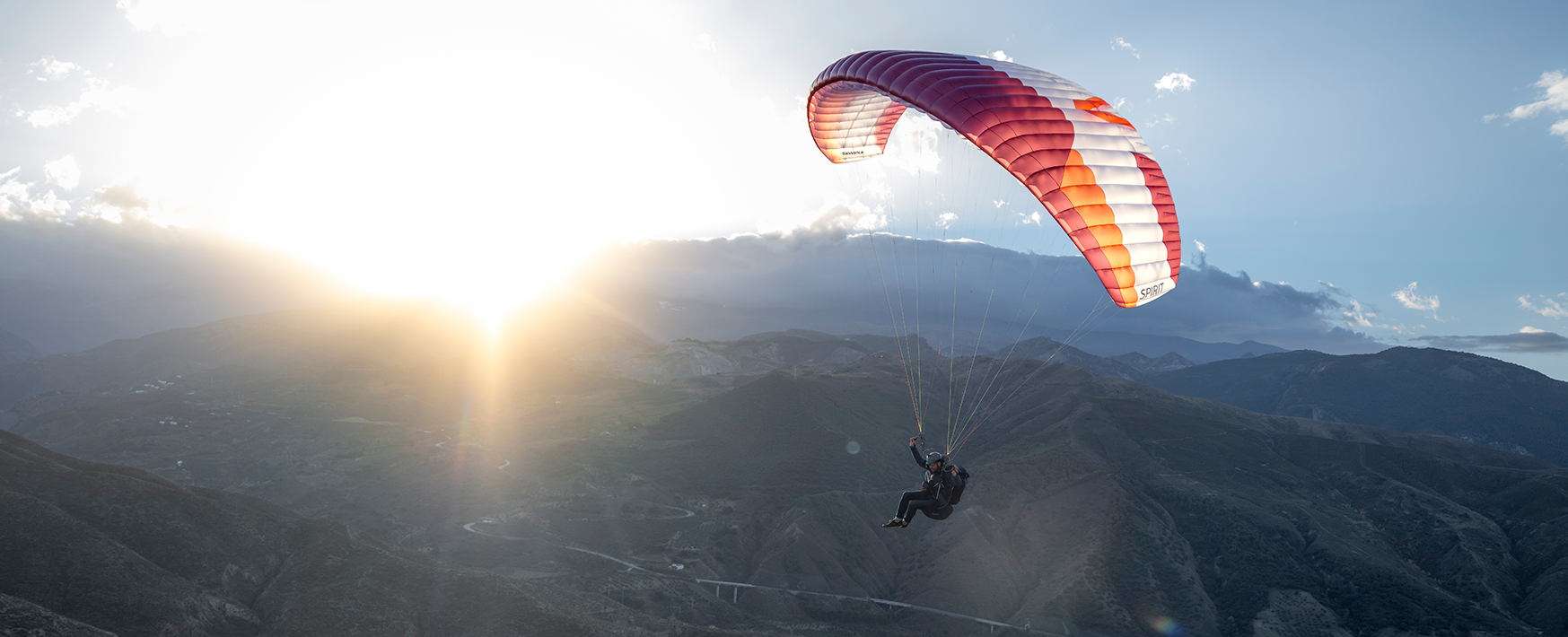
SPIRIT: expand your horizon
Alpinism. In each cell. Small backpack, big projects.
HOW DOES THE SPIRIT FLY?
The compact wing enables take-offs on the smallest of surfaces; all it takes is a slight impulse and the canopy rises reliably above the pilot. Since the wing generates lift quickly, the take-off distance to lift-off is correspondingly short, so even launches in technically demanding terrain are successful.
In the air, the SPIRIT reacts lively and directly to control impulses due to its small wingspan and short lines. The wing reactions vary dynamically depending on the wing loading. In turbulence, the SPIRIT is very stable, but requires a little experience and an active flying style at high wing loading due to its agility.
Despite its low weight, the SPIRIT was not only designed as an ultra-light descent glider, but also offers sufficient performance to glide out of long valleys and – depending on the wing loading – can also be used for thermal flying.
Whether from first flights to outlandish expeditions, the SPIRIT is always the first choice for alpine adventures!
JET FLAPS
Skywalks's JET FLAPS extend the green arc as you approach the stall point, which substantially increases safety and also improves climb performance.
SHARK NOSE
Together with a corresponding wing design, the shark nose technology improves pressure distribution in the canopy substantially. Advantages: much more solid flying feeling and substantial performance gain, especially when gliding on bar.
RIGID FOIL
The Rigid Foil nylon wires on the leading edge help maintain its shape and ensure constant ram air pressure. Advantages: better takeoff behavior, more performance and lower canopy weight.
3D-SHAPING
A precise calculation of the leading edge geometry and the installation of an additional strip of fabric reduce wrinkling in this sensitive part of the glider. Advantages: exact wing shape, more performance.
MINI RIBS
Doubling the number of cells at the trailing edge increases its shape stability substantially. Advantage: fewer vortices improve the aerodynamics and with it the performance.
LOOPS & HOOKS
Two sewn-in loops on the top surface in the leading edge area enable straps to be attached with a few pins, in order to to lay out the canopy in difficult alpine terrain.
AUTOMATIC SAND RELEASE SYSTEM
Porous openings of the profile ribs at the trailing edge ensure that sand and dirt in the glider are automatically guided to the wingtip where they can trickle out. This helps preserve the material and “relieves” the trailing edge.
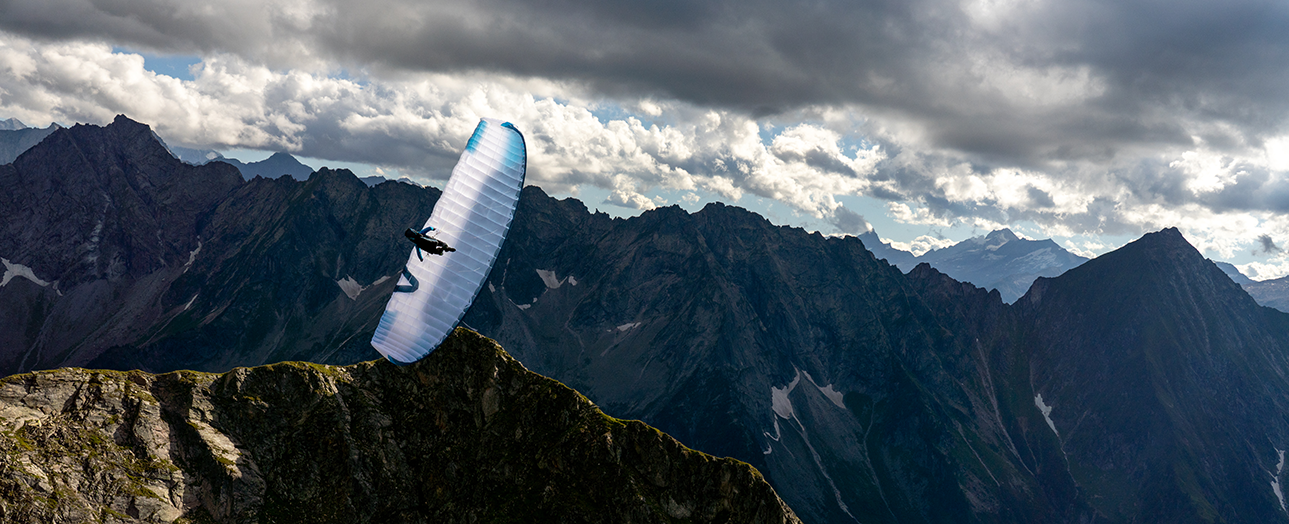
Materials
| Upper sail |
Dominico 10D |
| Bottom sail |
Dominico 10D |
| Diagonals |
Porcher Skytex 27 hard |
| Straps |
Porcher Skytex 27 hard |
| Main lines |
Liros PPSLS 180/125 |
| Middle lines |
Edelrid 8000U - 90/70; Liros DC60 |
| Top lines |
Liros DC60 |
| Breaklines |
Liros DFLP 200/32, Edelrid 8000U - 90/70, Liros DC60 |
| Risers |
Cousin 7 mm webbing |
FAQ
How do I calculate my take-off weight?
Takeoff weight is calculated by adding the weight of the pilot including clothes to the weight of the equipment. The equipment consists of the harness, the reserve chute, the paraglider itself, and any flight instruments and other baggage you may carry (e.g. rucksack, etc.).
What are "Loops & Hooks" and how do I use them?
In difficult terrain, you can loop in the hook pins at the loops. The hook pins are then weighted down with an object (stone, branch, etc.) or lightly stuck into the ground. The leading edge thus remains open and the glider does not slip away in steep terrain.
Is the deterioration on light-cloths higher than on a regular glider cloth?
Light-cloths are thinner than conventional glider-cloths and therefore less resistant against mechanical strain. That means you need to pay more attention on small rocks and bushes. Please avoid any unnecessary contact to the ground. With this strict observance you will have the same durability as with a conventional glider-cloth.
What are the glide ratio (L/D), trim and maximum speeds?
We know that these data are interesting for you as a pilot, but for us to publish them would be a bad idea for the following reasons:
1) Performance data are highly dependent on the drag of the pilot and are thefore related to sitting position and harness. The difference between aerodynamically favorable and unfavorable harnesses and sitting positions can be as much as a whole L/D number.
2) Performance increases with the size of the glider. A large glider will always outperform the same glider in a smaller size. So a question about the performance of a glider is always also a question about the size.
3) There is no normed method of testing the performance of paragliders. For example, speed varies with altitude and the associated different air pressure, but also with the total weight of the system.
That means that there simply isn’t THE speed or THE L/D that would allow a serious comparison with another glider. Performance data are dependent on the harness, the size of the glider, on the air mass and the total weight.
Is it OK for me to shorten the brake lines on my skywalk paraglider?
Changing the length of the brake lines can have a negative effect on the flying characteristics and extreme flight behavior. The paraglider needs a little more lead when flying on speed bar, otherwise the glider could be braked unintentionally, leading to a loss of performance. When performing extreme flying maneuvers, shortening the brake lines too much can cause complications during recovery from collapses, parachutal stall, etc.
Am I allowed to make modifciations to my skywalk paraglider?
No, because the glider is certified the way it is delivered to you. Even the brake line length is part of the trim and must not be changed.
What are JetFlaps and how do they work?
Jet Flaps are a so-called split flap like those seen on a large airplane. When the glider is braked, the airflow is routed through the glider, restoring smooth airflow. This extends brake line travel and softens the stall behavior.
What advantage do the JetFlaps on my skywalk paraglider offer?
Lower flyable minimum airspeed. The speed range is wider and easier to control. The pilot has more time to react when flying near the stall point.
Do the nylon wires in the glider need any special attention or packing method?
Our nylon wires are flexible and kink resistant, so they won’t break under normal circumstances. But due to the packing volume it is a good idea to lay the Rigid Foils in the leading on top of each other on both sides.
Skywalk service info & FAQ
Read Skywalk service info and answers to FAQ.
Downloads







